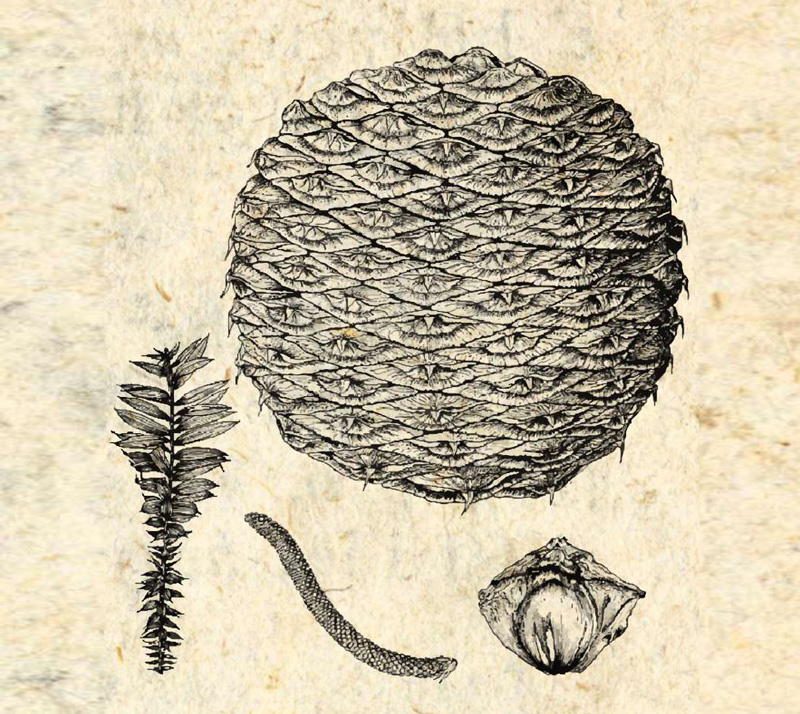Beginning of new growth
Photo: The cone of the Bunya Pine Araucaria Bidwillii.
John Carne Bidwill
Bidwill wrote in 1849 that he earned more than £500 a year for doing what was only a pleasure.
The eldest of seven children, and although educated for a commercial life, he became very interested in botany. Bidwill arrived in Australia in 1838 and went to New Zealand six months later to investigate the possibility of establishing a branch of the family business there.
He undertook at least two trips to the north island, exploring and collecting plant specimens, some of which he sent to contacts in London. In a number of instances, he became the first white person into visit certain locations and on his first trip climbed the active volcano, Ngauruhoe. Bidwill is credited with being the first person to do so as the mountain was ‘tapu’ (forbidden to visit) to the natives. This action offended the very powerful Maori chief, Te Heuheu Tukino II, who left a lasting impression on him.
Perhaps it was his seven-foot statute or his well-proportioned physique or maybe his reputation as a superb military tactician, a great military general and a wise counsellor that so impressed JC Bidwill. He later named the place area where built his barracks on the southern side of the Mary River, ‘Tinana’, which it is believed he sourced phonetically from ‘Te Heuheu’.
Bidwill’s experiences in New Zealand saw him publish Rambles in New Zealand (1841) to critical acclaim in London. Originally only 600 copies of the book were produced.
Although based in Sydney Bidwill continued travelling around botanising as he went. In late 1842 when at Moreton Bay he visited Durandur, situated to the north west of Brisbane (near current day Woodford) and near there collected small Bunya Pine seedlings. These and other specimens, he took to London the next year and sold them there at auction.
The Bunya Bunya (bunya pine) had been discovered by Andrew Petrie in 1838 and incorrectly called Pinus Petrieana (it was not a pine tree). In 1842 Bidwill published the first account of the bunya pine in Australia, which was later reprinted in England. In recognition of his work the tree was scientifically renamed Araucaria Bidwillii causing much angst with the Petrie family.
While visiting London with a large number of Australian plants, his Sydney business became insolvent in the 1840s depression, however with the backing of influential and prominent local contacts, on his return he then set up a nursery. Bidwill introduced plant breeding to Australia, being involved in experiments to hybridise gladioli, hibiscus and amaryllis. His hibiscus crosses were the first scientifically created examples in Australia.
Still looking for economic opportunities, in 1845 he ventured to Tahiti to try and establish commercial passionfruit growing on the island. The timing of this enterprise proved very poor as Tahiti was in civil disorder at the time due to the French having just deposed the Queen. His venture failed and he returned to Sydney later in that year.
With the support of his friends and the Governor, Bidwill landed his dream job as Director of the Botanical Gardens in Sydney. Unfortunately for him he was officially only in that role for three weeks as the Colonial Office in London had appointed another person to that position, which surpassed the local selection. Bidwill was extremely bitter about being replaced.
For consolation, in late 1848, the Governor appointed John Bidwill as Commissioner of Crown Lands for Wide Bay based at Maryborough. Bidwill’s duties, apart from his Commissioner’s role overseeing Crown lands, included Chief Magistrate, Clerk of Petty Sessions (until the arrival of a clerk in mid-1850) and Harbour Master. He also was expected to perform of role of officiator at weddings (he officiated in at least one wedding) and conduct burial services. For all of these duties he was given no instructions or forms on how to undertake them.
Bidwill built a barracks at the place he named Tinana and there he and began to plant a botanic garden with both local and imported plant specimens.
In 1850 he volunteered to mark out a quicker and more direct route from Maryborough to Brisbane closer to the coast as previously all land transport came and went overland via the South Burnett or along the Mary Valley and over the steep range. Perhaps he wanted this job to enable him to botanise a new area. When undertaking this task in 1851, while his party was constructing a make shift bridge over the Mary River near what is now Gympie, he was credited with finding the first traces of gold, 16 years before James Nash found the Gympie gold fields. Further south, he and another man went ahead of the others to try and discover a way through the impenetrable scrubs but both became lost in the bush for eight days with no food after Bidwill confused Mt Cooroora (near today’s Pomona) with Mt Beerwah, one of the Glass House Mountains, which he had seen and climbed from the south. They were eventually rescued by local aborigines and taken to a nearby station, Durandur, the most northern one in the Moreton Bay area.
Soon after this abortive journey Bidwill’s health started to deteriorate and although seeking medical attention in Sydney, he became more incapacitated and able to perform fewer of his roles. John Carne Bidwill died on March 16, 1853 at his residence, Tinana. He was only 38 years old.
He was buried on his property on a river terrace overlooking his botanic garden.
Only one surviving tree at his Tinana garden exists, a longan tree, while a Bunya Pine and a sausage tree in Queens Park are believed to have been descendants or come from his garden.
Although relatively historically forgotten, JC Bidwill is remembered by the genus Bidwillia and twelve species of native Australian and New Zealand plants that commemorate his name plus the locality of Bidwill, south of Maryborough and the suburb of Bidwill in western Sydney.

